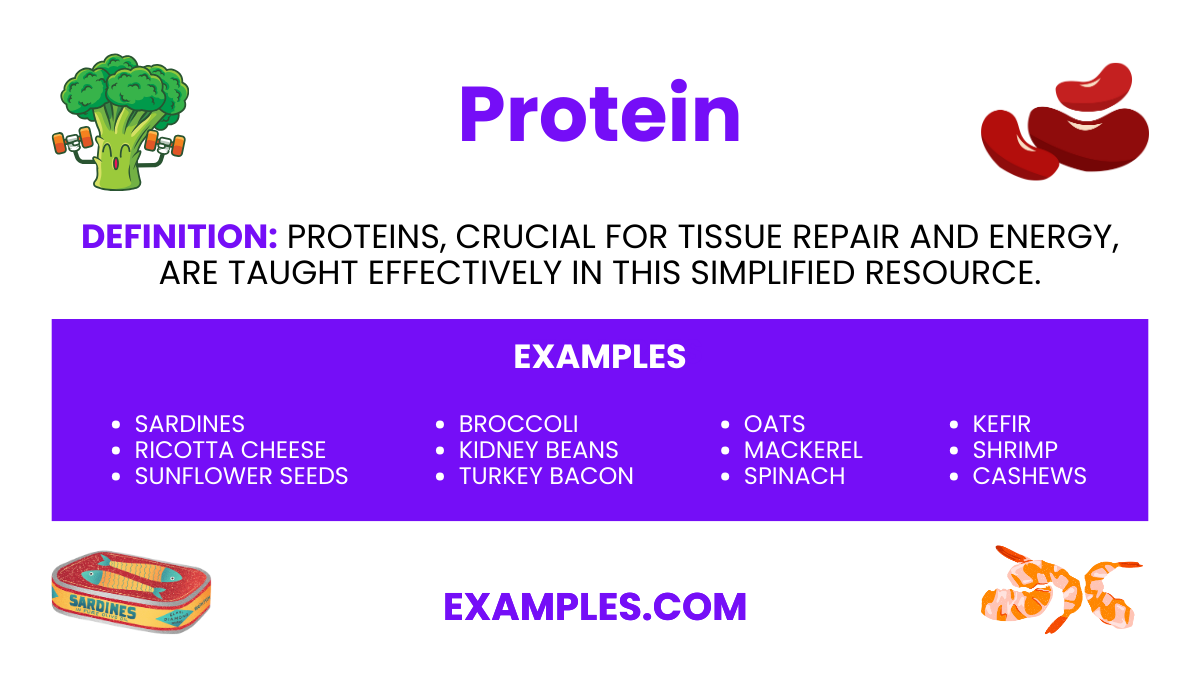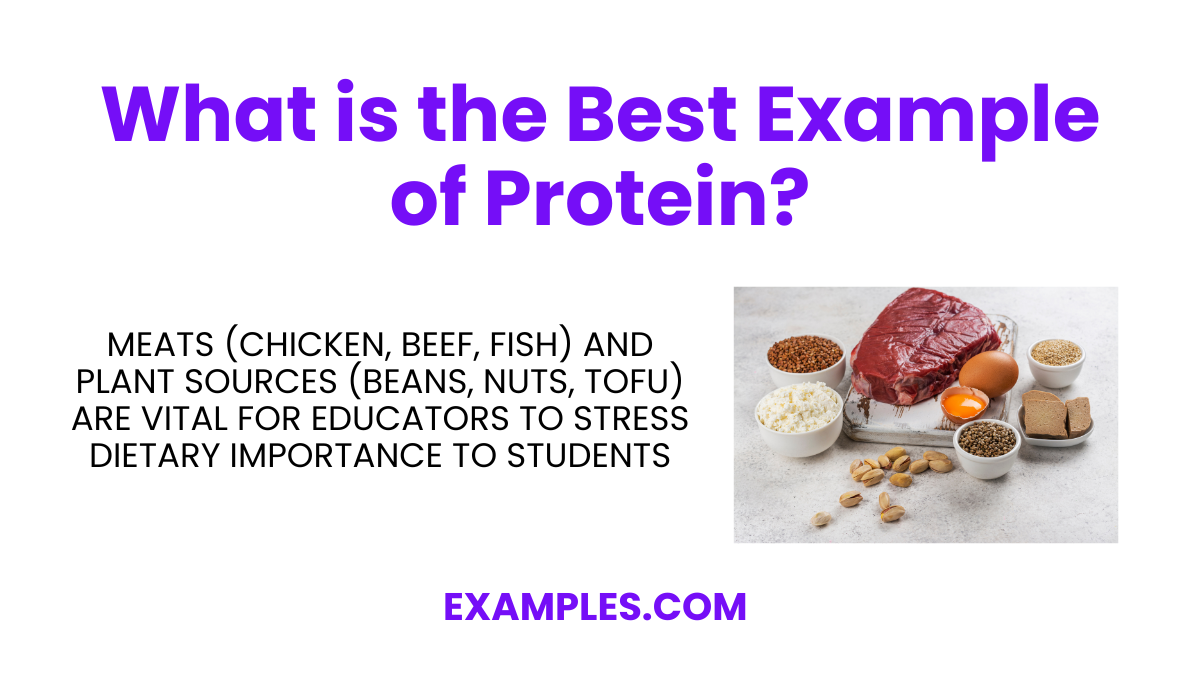What are the building blocks of proteins?
Monosaccharides
Nucleotides
Fatty acids
Amino acids

Proteins are essential macronutrient, plays a pivotal role in building and repairing tissues, and providing energy. This guide is crafted for educators, presenting protein in an accessible and engaging manner. It’s packed with examples and explanations, making it easier to teach students about the importance of protein in a healthy diet. From its basic definition to its critical functions, this resource simplifies complex nutritional concepts for learners at all levels.
Protein, a vital macronutrient found in both animal and plant sources, contains essential amino acids and elements like oxygen, sulfur, carbon, hydrogen, and nitrogen. Crucial for energy, tissue repair, and growth, it’s integral to a healthy diet. Excessive intake, however, can be harmful. Protein’s importance is recognized in various industries, including health and fitness, where it’s often marketed in products like protein shakes, although these typically carry no therapeutic claims.

The best examples of protein-rich foods include meats like chicken, beef, and fish, as well as plant-based sources such as beans, nuts, and tofu. These foods provide essential amino acids necessary for the body’s growth, repair, and maintenance. Understanding these examples is crucial for educators, as it helps students recognize the importance of incorporating protein into their diets for overall health and well-being.
The formula for protein is not as straightforward as for simpler molecules because it’s composed of long chains of these amino acids. Each amino acid has its own unique structure but follows a general formula:
In this formula:
Proteins are the building blocks of life, essential for growth, repair, and overall health. For educators and students alike, understanding various protein sources is key to a balanced diet. This list provides 20 diverse protein examples, each with unique benefits and uses. From classic animal-based options to plant-based alternatives, these examples cover a wide range of dietary needs and preferences. Ideal for teaching nutrition, these protein sources are explained in simple terms, making it easy for students to grasp and incorporate into their diets.
Proteins, essential for bodily functions, come in various types, each serving unique roles. Understanding these types is crucial, especially for educators teaching nutrition and biology. This guide details the different protein types, their sources, and functions, making it easier for students to grasp their importance in a healthy diet. From animal-based to plant-based proteins, we cover the spectrum, providing the best examples for each type. This comprehensive overview aids in understanding how different proteins contribute to overall health and well-being.
Proteins, vital macronutrients, play several crucial roles in the body. They are fundamental for building and repairing tissues, making enzymes, hormones, and other body chemicals. Proteins are also key components of bones, muscles, cartilage, skin, and blood. Unlike carbohydrates and fat, the body does not store protein; hence, it must be continually replenished through diet. A balanced intake of protein supports immune function, aids in nutrient transportation, and contributes to overall health and well-being.
Protein is a powerhouse macronutrient essential for the human body. It plays a crucial role in building and repairing tissues, including muscles, skin, and organs. Proteins are fundamental in producing enzymes, hormones, and other vital chemicals. They contribute significantly to immune function, form the building blocks of bones, muscles, cartilage, and skin, and are necessary for oxygen transport and nutrient storage. Regular protein intake aids in maintaining a healthy metabolism and supports weight management by promoting satiety.
Proteins are crucial macronutrients found in a variety of foods. They are essential for building muscles, repairing tissues, and maintaining overall health. Animal sources like meat, poultry, fish, and dairy products are rich in protein. Plant-based sources include beans, lentils, tofu, nuts, and seeds. Whole grains and vegetables also contribute to protein intake. A balanced diet incorporating these foods ensures adequate protein consumption, supporting bodily functions and promoting health.
Proteins are composed of amino acids, which are organic compounds made up of carbon, hydrogen, oxygen, nitrogen, and sometimes sulfur. These amino acids are linked together by peptide bonds, forming long chains. There are twenty different amino acids that can be combined in various ways to create different proteins. Each protein’s unique structure and function are determined by the specific sequence and arrangement of these amino acids.
This guide provides educators with the necessary information to teach about the diverse sources and chemical composition of proteins.
Understanding the practical challenges associated with protein consumption and metabolism is crucial. One major issue is balancing protein intake to avoid both deficiency and excess, which can lead to health problems. Protein deficiency can result in muscle wasting, weakened immunity, and overall poor health. Conversely, excessive protein, particularly from animal sources, is linked with kidney strain, heart disease, and osteoporosis.
Protein is much more than a dietary necessity; it’s a powerhouse that performs a plethora of functions in the human body. Each function is essential for maintaining good health and supporting life’s processes:
For some who may wonder what knowledge of the macronutrient protein be used for, the following would be your answer. We know what protein is, and we know what it can do for the body. So here are some tips on what you can use protein for. From food, diets, topic for discussion, speech, research, medical uses and medical assessments.
Health speeches are a good way to know more about protein. Especially when you are preaching to people who may have little to no information of why it is good for them. Making health speeches to those who need it most can actually help them understand that protein is beneficial and with this, you are also advertising if you do own a business. It’s basically hitting two birds with one stone.
SOAP assessments are one of the most common things found in medical workers. Especially when it comes to their patient’s overall health and well being. This assessment is also able to help understand and explain to patients about the necessary details in the assessment being given. Health wise patients often like asking about anything that involves their wellbeing and this also means their protein intake.
What better way to introduce what protein is than to have it as a subject to be discussed in class. Whether it may be for middle school students, high school or even students taking up a medical field. The discussion of proteins in class would not only make it more interesting, it would also highlight the fact that this subject can be talked about anytime to any age difference.
When you do research, especially when it comes to foods either for business or for personal reasons, you may encounter the different macronutrients, one of which is protein. Doing research helps you learn more and with the knowledge that you gain, you may use it for personal reasons as mentioned earlier or even to do business with. If you plan on starting out your own business with protein rich foods, doing your research should be easier.
If you are a writer or a blogger, you would know by now that the best thing to do when writing about a topic is to do research. Especially if your articles may be about health and wellness. Writing an article or an essay about protein and the foods that fall under it would not only be beneficial to your writing, but it would also give others a better view of what protein foods can do. To be able to look at it in a different light than in a scientific light.
Foods like red meat, cheese and drinks like milk and protein shakes are good examples of foods and drinks that have protein.
Depending on how much protein you may need for a good reason. However, there are some nutritionists who would not suggest protein drinks as a good way to gain more protein due to the higher dose of sugar.
This is the end of the article. To recap, protein and carbohydrates are the macronutrients that the body needs. There are some foods that do contain protein. But any medical team and nutritionist would tell you that too much of protein can also be considered bad for anyone’s health. A lot of businesses would often use protein as a business topic or business opportunity especially when there are a lot of people who are health conscious which is fine.
Text prompt
Add Tone
10 Examples of Public speaking
20 Examples of Gas lighting
What are the building blocks of proteins?
Monosaccharides
Nucleotides
Fatty acids
Amino acids
Which of the following is a function of proteins in the body?
Energy storage
Catalyzing biochemical reactions
Insulation
Genetic information storage
What type of bond links amino acids together in a protein?
Glycosidic bond
Hydrogen bond
Peptide bond
Ionic bond
Which of the following is a complete protein source?
Rice
Wheat
Chicken
Corn
Proteins differ from one another because:
They have different types of sugars.
They are composed of different types of nucleotides.
The sequence of amino acids in their polypeptide chain varies.
They have different types of fatty acids.
What is the primary structure of a protein?
The three-dimensional shape
The sequence of amino acids
The folding pattern
The interaction between multiple polypeptides
What are enzymes?
Lipids that store energy
Carbohydrates that provide structural support
Proteins that speed up chemical reactions
Nucleic acids that store genetic information
Which protein is responsible for oxygen transport in the blood?
Insulin
Hemoglobin
Collagen
Actin
Proteins can be denatured by:
Freezing temperatures
Neutral pH
High temperatures and extreme pH
Low salt concentration
Which of the following is an essential amino acid?
Alanine
Glycine
Serine
Lysine
Before you leave, take our quick quiz to enhance your learning!

